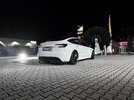Olle
Active Member
That's my take on the Model 3 suspension too. What confuses a little though is that Model S suffers from the same challenges, actually a little worse, since it has even longer wheelbase. But the S strikes me as having plush, long travel suspension and feels well balanced. To campare apples to apples I am talking about the non air suspension S (discontinued). Thoughts?The challenge with the Model 3 suspension is first, you need skinny overinflated tires for good efficiency. This makes the ride harsh.
Second, you need firm shocks for good efficiency. Just like on a mountain bike, cushy shocks eat energy so they make 'em firm.
Third, the car should be low for good efficiency, handling, and aesthetics, but the battery dictates a very long wheelbase so the result is a car that's very prone to high-centering. The solution is to make the suspension springs wildly progressive by nominally riding on the urethane foam bump stops at all times rather than just hitting them when bottoming out. The result is an odd-feeling response to quick inputs or bumps.





